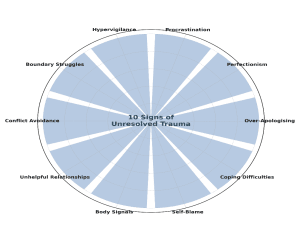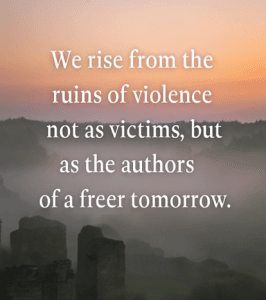Unresolved trauma often hides in plain sight. If you’re here, you may already wonder why certain habits, emotions, or patterns keep circling back no matter how hard you try to move on. This guide is for survivors—for anyone living with the lasting imprint of tough experiences. It isn’t here to diagnose you or label you. It’s here to offer understanding, validation, and gentle, doable pathways for healing.
For many, an abusive childhood affects adulthood in ways that are subtle, long-lasting, and sometimes misunderstood. Childhood trauma in adulthood may show up not only as memories but also as daily habits, relationship struggles, or even physical health issues.
The signs of unresolved trauma are diverse. They can look like everyday habits, relationship difficulties, or quiet battles within yourself. I hope to help you recognise these signs with compassion and to offer survivor-affirming strategies you can try at your own pace.

1) Over-Apologising & People-Pleasing: A common sign of Unresolved Trauma
What’s happening
If you apologise for asking a question, offering a preference, or simply taking up space—you’re not alone. For many survivors, apologising and pleasing were clever ways to stay safe in unpredictable environments. Your nervous system learnt that harmony might keep you from harm.
Everyday signs
- “Sorry for bothering you…” on repeat
- Saying “yes” while your body says “no”
- Feeling responsible for others’ moods
Kind supports
- Notice without judgement. Awareness is healing, not failure.
- Swap “sorry,” for “thank you.” “Thank you for waiting.”
- Practise tiny ‘No’s.’ “I can’t this time, but thank you for asking.”
- Reflect on ‘why now?’. Am I avoiding conflict or owning a mistake?
- Get support. Trauma-informed therapy can help you reclaim space.
2) Perfectionism & Hyper-Productivity: When Childhood Trauma in Adulthood Shows Up as Overwork
What’s happening
“When I’m perfect, I’m safe.” Perfectionism often grows where love felt conditional or chaos demanded control.
Everyday signs
- Guilt for resting; work as self-worth
- Fear of errors; all-or-nothing thinking
Kind supports
- Name the shame spiral. Mistakes ≠ being “bad”.
- Good-enough practice. Hand in work without ten extra edits.
- Rest as resistance. Your nervous system needs it.
- Softer self-talk & CBT skills. Catch extremes; choose balance.
- Therapeutic care. Healing asks you to be human, not perfect.
3) Procrastination & Decision Paralysis: How an Abusive Childhood Affects Adulthood Choices
What’s happening
This isn’t laziness. It’s protection. If the system punished choices or if dangerous mistakes occurred, your system might freeze.
Everyday signs
- Over-researching, endless lists, no movement
- Feeling “frozen” by simple choices
Kind supports
- Lead with compassion. Ask, “What feels unsafe here?”
- Shrink the task. One ten-minute step counts.
- Ground the body. Breath, feet on floor, orient to the room.
- Shame literacy. “I’m stuck—and that makes sense.”
- Trauma-informed coaching/therapy to rebuild choice safety.
4) Hypervigilance & Heightened Sensitivity: Another Sign of Unresolved Trauma
What’s happening
Hypervigilance is an intelligent survival response. It’s exhausting to live with, but it kept you here.
Everyday signs
- Startles easily; over-analysing tone and silence
- Tension, poor sleep, never fully “off”
Kind supports
- Five-senses grounding. Name five things you see, four you feel…
- Slow breathing (e.g., 4-7-8).
- Gentle movement/yoga. Let the body exhale.
- Mindfulness—trauma-sensitive, short, stoppable, kind.
- Somatic therapies to calm the internal alarm.
5) Boundaries & Co-dependency: The Lingering Echo of Childhood Trauma in Adulthood
What’s happening
If “no” feels dangerous, that’s history speaking. People often ignored or punished your needs, and that’s where co-dependency often grows.
Everyday signs
- Guilt after saying no; rescuing others at your expense
- Staying in draining dynamics to avoid abandonment
Kind supports
- Start small. “I can talk tomorrow.”
- Scripts help. “I won’t be able to take that on.”
- Name your limits & values. Your needs matter.
- Expect guilt at first. It’s a sign of fresh growth.
- Group/therapy support for skills and solidarity.
6) Conflict Avoidance & Emotional Numbing: How an Abusive Childhood Affects Adulthood Emotions
What’s happening
If conflict once meant danger, your body may shut feelings down to protect you. Numbing shields pain—but also blocks joy.
Everyday signs
- Avoiding hard conversations; peacekeeping at your cost
- Feeling detached, going through the motions
Kind supports
- Ground back in. Touch, sight, sound—anchor here.
- Safe expression. Journal, draw, voice-note.
- Build language. Use an emotion wheel.
- Tiny exposure. One honest sentence; then care for yourself.
- Therapeutic space to feel what once was unsafe to feel.
7) Relationship Patterns: Fear of Abandonment vs. Hyper-Independence
What’s happening
Trauma shapes attachment. You might cling to avoid loss—or armour up to need no one. Both are understandable.
Everyday signs
- Seeking constant reassurance; leaving first to avoid being left
- Refusing help; isolation wrapped as strength
Kind supports
- Learn your pattern. Anxious, avoidant, mixed knowledge soothes.
- Practise both/and. Autonomy and connection.
- Choose safe people. Slow, steady trust.
- Attachment-focused therapy to restore safety in closeness.
8) Body Signals: Pain, Tension, and Digestive Issues as Signs of Unresolved Trauma
What’s happening
The body keeps the score and the story. Pain, fatigue, and gut issues can be trauma’s language.
Everyday signs
- Neck/shoulder pain; headaches; IBS-type symptoms
- Fatigue, poor sleep, autoimmune flares
Kind supports
- Gentle movement. Walks, stretching, trauma-informed yoga.
- Body scans & relaxation. Befriend the body.
- Compassionate care. “My pain is real.”
- Trauma-informed clinicians. Whole-person support.
- Mind-body practices. Nature, warmth, safe touch.
9) Self-Blame & Harsh Self-Talk: A Legacy of Childhood Trauma in Adulthood
What’s happening
When the world minimised your pain, you may have internalised the blame. The inner critic echoes old voices.
Everyday signs
- “It was my fault.” Minimising your story.
- Struggling to accept care or compliments.
Kind supports
- Speak to yourself kindly. As you would to someone you love.
- Question the critic. Whose voice is this? Is it true?
- Rewrite your story. “I did the best I could with what I had.”
- Notice the good. Keep a small wins/kindness journal.
- Peer spaces dissolve isolation and shame.
10) Struggling to Self-Soothe: When an Abusive Childhood Affects Adulthood Coping Skills
What’s happening
If your system is stuck in survival, numbing can feel like the only relief. These strategies once helped you cope.
Everyday signs
- Substance use, overeating, overwork, self-harm urges
- Struggling to settle after triggers
Kind supports
- Create a soothing toolkit. Textures, scents, music, photos, beads.
- Practise regulation. Slow breaths, self-hug, warmth, movement.
- Attune to need. Ask your body, “What would help right now?”
- Add before removing. Introduce helpful habits; reduce the rest.
- Therapeutic and /or peer support for safer regulation and care.
Closing: Healing Beyond the Signs of Unresolved Trauma
Recognising these signs of unresolved trauma isn’t about blame—it’s about honouring how brilliantly you survived. Every pattern here is an adaptation. Healing means gently unlearning what no longer serves you and reclaiming safety, self-worth, and connection—on your terms.
If you’ve ever wondered how an abusive childhood affects adulthood or how childhood trauma continues to shape your daily life in adulthood, this guide should reaffirm that you are not broken. Healing is possible. Your kindness to yourself is an act of resistance against everything that tried to silence you.
What’s happening
If your system is stuck in survival, numbing can feel like the only relief. These strategies once helped you cope.
Everyday signs
- Substance use, overeating, overwork, self-harm urges
- Struggling to settle after triggers
Kind supports
- Create a soothing toolkit. Textures, scents, music, photos, beads.
- Practise regulation. Slow breaths, self-hug, warmth, movement.
- Attune to need. Ask your body, “What would help right now?”
- Add before removing. Introduce helpful habits; reduce the rest.
- Therapeutic/peer support for safer regulation and care.
Closing: You Are Whole
Recognising trauma’s fingerprints isn’t about blame—it’s about honouring how brilliantly you survived. Every pattern here was an adaptation. Healing invites you to unlearn gently what no longer serves you and rebuild safety, self-worth, and connection—on your terms.
Progress is rarely linear. Take tiny steps. Celebrate small shifts. Look for spaces—online or in your community—that understand trauma and welcome your voice. When shame gets loud, remember you are not to blame for the wounds you carry. Help is available. Your kindness to yourself is an act of resistance against everything that tried to silence you.
Snapshot: 10 Signs of Unresolved Trauma & Gentle Responses
| Sign of Unresolved Trauma | What It Can Feel Like | Survivor-Centred Supports |
| 1. Over-Apologising & People-Pleasing | Saying “sorry” for existing; keeping the peace to stay safe. | Notice the pattern; swap “sorry” for “thank you”; practise tiny boundaries; reflect on triggers; seek supportive therapy. |
| 2. Perfectionism & Hyper-Productivity | Achieving to feel “enough”; fearing mistakes. | Name shame triggers; allow “good enough”; rest as resistance; kinder self-talk; CBT skills. |
| . Procrastination & Decision Paralysis | Feeling stuck, avoiding choices, overwhelm. | Lead with self-compassion; break tasks down; explore safety needs; body-based grounding; trauma-informed support. |
| 4. Hypervigilance & Heightened Sensitivity | Always on alert; scanning for danger or rejection. | Grounding with the senses; slow breathing; gentle movement; trauma-sensitive mindfulness; somatic therapies. |
| 5. Boundary Difficulties & Co-dependency | Struggling to say “no”; feeling responsible for others’ feelings. | Start small; use scripts; clarify limits; expect guilt (growth); peer/therapy support. |
| 6. Conflict Avoidance & Emotional Numbing | Panicking at confrontation; shutting down feelings. | Grounding; safe expression (journal/art/voice notes); build emotion vocabulary; gradual exposure; supportive therapy. |
| 7. Unhelpful Relationship Patterns | Fear of abandonment or “I need no one” hyper-independence. | Explore attachment roots; practise balanced interdependence; seek safe relationships; attachment-focused therapy. |
| 8. Body Signals (Pain, Tension, Gut Issues) | The body carrying what words can’t. | Gentle movement; body scans; compassionate body care; trauma-informed medical support; mind-body approaches. |
| 9. Self-Blame & Harsh Self-Talk | “It was my fault,”; feeling broken or unworthy. | Mindful self-compassion; challenge the inner critic; rewrite your narrative; notice wins; connect with peers. |
| 10. Struggling to Self-Soothe | Turning to numbing substances, overwork, compulsions. | Build a coping toolkit; practise soothing skills; increase attunement; “replace, don’t just remove”; therapeutic support. |

Resources for Continued Support
- CPTSD Foundation – Hidden Signs of Unresolved Trauma
- Our Mental Health – Self-Soothing Strategies for Trauma Survivors
- Positive Psychology – Self-Soothing Techniques & Strategies
- The Trauma & Mental Health Report – Toxic Productivity & Rest
- Verywell Mind – Unresolved Trauma & Healing
- Psychology Today – Undoing Emotional Numbing
- Mind (UK) – Coping with Trauma